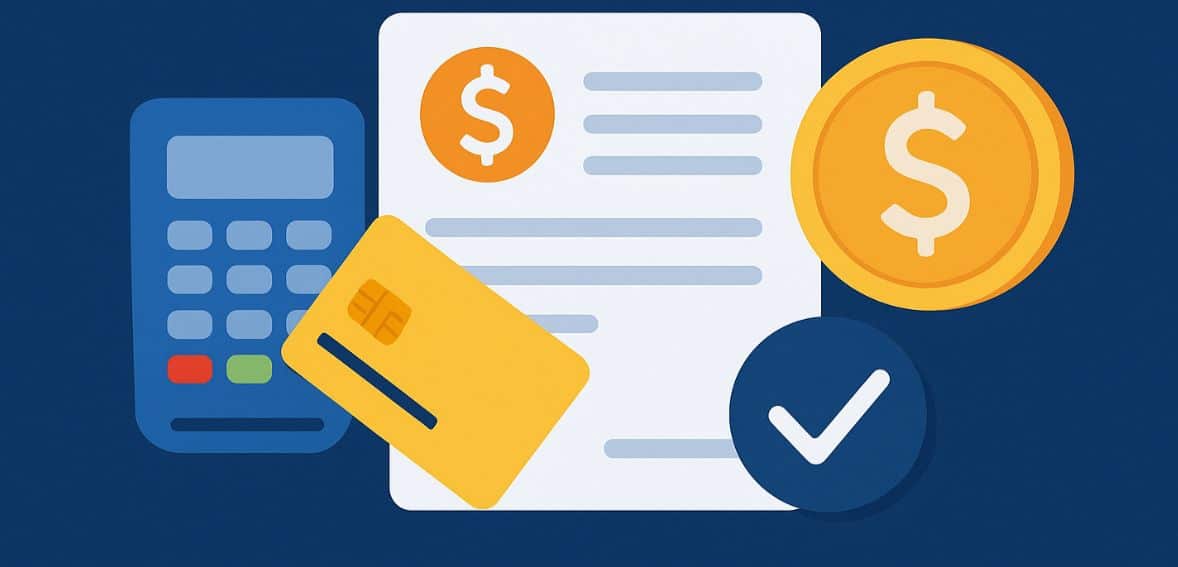
By Carol Sherman August 20, 2025
Most business owners only see a payment being made when a customer inserts, swipes, or taps a credit card at the point of sale. After a minor deduction, money eventually makes its way from the customer’s account to the business’s bank account. However, a much more intricate system operates behind the scenes to keep contemporary commerce running.
Interchange fees, the unseen fees that serve as the foundation of card-based payment networks, are at the core of this system. These fees are among the biggest expenses associated with using credit and debit cards for businesses; they are not merely small technical issues.
It is crucial for entrepreneurs of all sizes to comprehend interchange fees. However, many people find these charges confusing and overwhelming due to the jargon, equations, and hidden structures involved. In actuality, interchange fees are intended to standardize the flow of money between banks, networks, and companies rather than to confuse. Nevertheless, they can have a significant effect on profit margins.
Understanding how interchange fees operate could make the difference between a small retailer’s or an expanding e-commerce startup’s high profitability and declining returns. This article explains interchange fees, their purpose, their calculation, and effective management strategies for business owners.
By demystifying this complex financial element, entrepreneurs can take more control over their costs, strengthen their understanding of payment processing, and make smarter decisions that protect their bottom line.
What Are Interchange Fees

Every time a credit or debit card transaction occurs, the merchant’s bank, also referred to as the acquiring bank, pays exchange fees to the customer’s bank, also referred to as the issuing bank. In the payment ecosystem, these fees—which are established by card networks like Visa, Mastercard, American Express, or Discover—act as a standardized means of striking a balance between risk and reward.
Interchange fees are passed through the merchant’s payment processor and included in the total processing fees, even though the merchant does not pay the issuing bank directly. To put it another way, when a consumer uses a card, the company not only reimburses the processor but also indirectly supports the interchange system that compensates banks for issuing and overseeing those cards. Exchange rates are not set in stone.
They are intended to cover a variety of justifiable costs incurred by issuing banks, including transaction processing, fraud prevention, and the price of extending credit to customers. Additionally, they encourage banks to issue more cards, which keeps the massively effective electronic payments system running.
Why Do Interchange Fees Exist
Examining interchange fees’ larger function aids in understanding them completely. Debit and credit cards are more than just bits of plastic; they are a component of a sophisticated financial system that enables safe, quick payments everywhere in the world. Several parties assume risk and accountability each time a customer makes a purchase. For example, the issuing bank effectively fronts funds on behalf of the cardholder.
When it comes to credit cards, they are offering a line of credit, which entails the risk of cardholder default. Fraud and disputes can expose the bank to financial risk even when using debit cards. Banks are partially compensated by exchange fees for assuming this risk and for offering services like fraud monitoring, customer support, and management.
From another perspective, interchange fees encourage customers to use the cards and reward banks for issuing more, which keeps the system running smoothly. The result is a payment network that rewards banks for maintaining the underlying infrastructure, helps consumers by providing convenience and rewards, and helps businesses by bringing in more clients.
How Are Interchange Fees Calculated

How interchange fees are calculated is one of the main things that confuses merchants. These fees are not uniform; rather, they differ based on a variety of factors, such as the kind of card, the transaction, the merchant’s size, and the method of payment processing. For instance, because the rewards provided to cardholders are partially financed by merchants, transactions involving premium rewards cards frequently have higher interchange rates.
Similar to in-person, chip-enabled transactions, card-not-present transactions—like online purchases—usually entail higher fees due to their increased risk and susceptibility to fraud. Interchange rate tables, which show the percentage charged and the flat fee per transaction, are published by card networks.
Despite being freely accessible, these documents can be very technical and difficult to understand. The pricing model used by their payment processor, which may either pass Interchange fees directly on to customers or combine them into blended rates, frequently affects the actual rate that a merchant pays in practice.
To remain resilient in uncertain economic conditions, businesses should avoid relying on a single capital source. A diversified funding portfolio—balancing debt, equity, and alternative financing—provides flexibility, reduces risk, and supports sustained growth.
The Impact of Interchange Fees on Businesses
Interchange fees are major operating expenses that have the potential to significantly affect a company’s profitability; they are not small inconveniences. Interchange fees can reduce profits in ways that are challenging to counteract with volume alone in sectors with narrow profit margins, like retail or food service. The strain is often greatest for small businesses.
Smaller merchants usually have little power to set terms, in contrast to large corporations that can negotiate better rates because of higher transaction volumes. In comparison to national chains, this implies that the typical coffee shop, boutique, or local service provider pays a higher effective rate.
The strain on retailers has also grown as premium credit cards with rewards programs have become more and more popular. Although customers benefit from travel points, cash back, or airline miles, companies that pay the higher interchange fees associated with those cards indirectly finance these benefits. This poses an issue for many businesses: while accepting some cards can result in a large increase in expenses, refusing them can drive away customers.
The Role of Payment Processors

The payment processor determines how Interchange fees are displayed to businesses, even though card networks set them. Processors serve as go-betweens for card networks, acquiring banks, and retailers. In addition to ensuring compliance and handling the technical aspects of transactions, they also include interchange fees in their pricing.
The merchant’s perception of these fees’ transparency may vary depending on the pricing model. Fees are itemized in an interchange-plus model, which displays both the interchange cost and the processor’s markup. However, interchange fees are combined into more general categories in a flat-rate or tiered model, which may mask the actual cost of each transaction.
Selecting the appropriate pricing model and processor can have a significant impact on business owners. A transparent model may be slightly more complex to understand, but it often provides better long-term clarity and control.
Global Variations and Regulation of Interchange Fees

Around the world, exchange rates vary. They are typically higher in the US than in other markets. Conversely, the European Union has placed stringent restrictions on consumer card interchange fees, bringing them down to a small portion of what American retailers normally pay. These discrepancies result from regulatory choices made to balance the interests of consumers, merchants, and banks.
Merchants frequently enjoy lower prices in markets where regulators step in, but banks may scale back their customer rewards programs as a result. Consumers may benefit from more extensive card benefits in less-regulated markets, but merchants incur greater costs.
The delicate balancing act that interchange fee systems entail is highlighted by this worldwide variation. If it is too high, merchants will suffer; if it is too low, banks will no longer be motivated to issue cards or invest in fraud prevention.
Can Businesses Reduce Interchange Fees
Although they are unable to directly negotiate interchange fees with card networks, merchants do have some control over the final cost. The best course of action is to optimize transaction processing. For example, utilizing contactless or chip-enabled payments lowers the risk of fraud, which may result in a lower applicable interchange category.
Reducing unnecessary expenses can also be achieved by making sure that data is transmitted accurately and transactions are settled quickly. In order to offset fees by passing them on to customers, some businesses investigate cash discount programs or surcharging. Although legal in some areas, these strategies can be contentious and run the risk of offending clients if not used with caution.
Working with processors that specialize in interchange optimization is an additional strategy that guarantees every transaction is routed and categorized in the most economical way possible. Ultimately, the best defense against interchange costs is awareness. Businesses that take time to understand the mechanics of interchange fees are better positioned to make informed choices about payment processing, customer pricing, and financial planning.
The Future of Interchange Fees
As payment technology evolves, so too will the structure of interchange fees. The rise of digital wallets, real-time payments, and alternative payment rails may eventually reshape how fees are distributed across the ecosystem. At the same time, increasing regulatory scrutiny around the world could bring more uniformity or caps to markets that currently operate with high interchange rates.
For merchants, the future of interchange fees will likely remain tied to broader trends in consumer behavior and technology adoption. The more consumers lean into digital payments, the more critical it will be for businesses to adapt and understand the costs associated with them.
Conclusion
Although exchange fees may be used in the background, there is no denying their influence on how businesses operate. A tiny but significant amount of each transaction made by a consumer using a credit or debit card goes through the interchange system, rewarding banks, maintaining card networks, and mitigating risk. Although these fees are mandatory for business owners, they can be controlled with the appropriate information and strategies.
Business owners can process payments more intelligently if they know what interchange fees are, why they exist, and how they impact various kinds of transactions. Merchants can optimize their processing setup, cut down on wasteful spending, and get ready for future changes in the payments landscape, even though they cannot eliminate interchange fees.
Although exchange fees are a necessary component of engaging in the contemporary payments ecosystem, they don’t have to be a barrier to profitability if one is aware of them and prepares ahead. Rather, they can be viewed as a single component of a bigger picture that enables companies to interact with clients, take payments easily, and prosper in a global economy that is becoming more and more reliant on digital transactions.